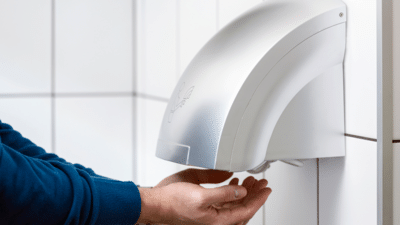
Hand dryers in public washrooms are often thought of as a cleaner and eco-friendly option compared to paper towels . But the truth is a little unsettling. These machines do not draw in fresh or filtered air.
Instead, they pull air directly from the same restroom environment, which is already filled with microscopic particles, bacteria, and even traces of faecal matter.
The hidden spray of germs
Every flush in a toilet releases a fine mist of particles into the air, a phenomenon known as the “toilet plume.” have shown that these particles can linger for hours and spread across the room. When a hand dryer sucks in this contaminated air and blasts it out at high speed, those germs land right back onto the skin. Freshly washed hands, in that moment, are no longer as clean as they should be.
Stronger airflow, stronger contamination
One of the biggest issues lies in the speed and force of the air. High-powered hand dryers can spread germs over a much wider area compared to just touching a surface. from the University of Leeds revealed that jet air dryers can spread 1,300 times more germs than paper towels. The very act of drying becomes a way of scattering bacteria onto clothes, face, and even the person standing nearby.

Not just about bacteria, mould and dust too
Restrooms are humid places, and humidity is the perfect breeding ground for mould and fungal spores. Hand dryers pull this damp, contaminated air in and circulate it back. Over time, this can expose skin to not just bacteria but also allergens that irritate the nose, throat, or skin. It becomes less of a drying device and more like a blower of invisible pollutants.
The false sense of “eco-friendliness”
Many offices and hotels switched to hand dryers as a sustainable replacement for paper towels. But when weighed against hygiene, this choice becomes questionable. A paper towel, once used, carries germs away and is thrown out. A hand dryer, on the other hand, keeps recirculating contaminated air again and again. In the long run, the health risk may outweigh the supposed environmental benefits.
What works better instead
If there is an option, drying with paper towels is still the safest and most effective method. They do not just dry hands faster but also help wipe away leftover bacteria after washing. In places where towels are not available, letting hands air-dry naturally is a safer option than standing under a dryer that blows restroom air onto clean skin.
Disclaimer: This article is for educational purposes only. It is based on scientific findings and studies conducted on hygiene practices in public restrooms. It does not aim to replace medical advice. For personal health concerns, consulting a healthcare professional is always recommended.
 Hand dryers in public washrooms are often thought of as a cleaner and eco-friendly option compared to paper towels . But the truth is a little unsettling. These machines do not draw in fresh or filtered air.
Hand dryers in public washrooms are often thought of as a cleaner and eco-friendly option compared to paper towels . But the truth is a little unsettling. These machines do not draw in fresh or filtered air.
